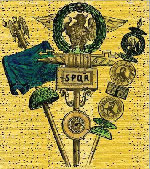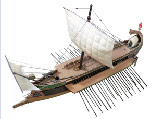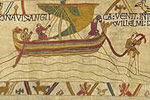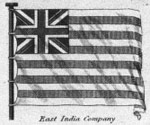THROUGHOUT the ages mariners have used visual signals to convey messages at a distance. A private signal distinguishes itself from a national flag or maneuvering message because it symbolizes a significant persona.
From as far back as 4000 BC, Egyptian captains of the Nile would identify themselves to passing ships by placing a clay figurine atop their ships’ aftermost cabin.

egyptian nile boat

roman standards

trieme

Bayeux Tapestry

East India Company
In 480 BC the Greek navy used a red cloak tied to an oar to signal the attack to repel the naval forces of Xerxes of Persia. Incidentally this was the first recorded use of a maneuvering signal at sea.
The Romans used private signals quite often. Roman military standards were cloth and embellished with silver shapes. They often hung from a transverse bar at the head of a pole. The person who would carry this portable flagpole was deemed the “standard bearer.”
At sea off Marseilles in 49 BC, the famous roman Brutus hoisted his private signal during a battle against the Massilians of Pompeii. Primary documents say the Massilians recognized his “flamboyant” signal, so his ship narrowly escaped being rammed simultaneously by two triremes.
In the Middle Ages private signals were used extensively at sea. The Bayeux Tapestry of 1150 AD shows “Mora,” the ship of William, Duke of Normandy, as it flew a white banner, bordered in blue and bearing a golden cross. Other knights in the tapestry boast their own private signals.
Great trading nations – Venice, Portugal and Holland – made use of signals throughout the modern age to identify their ships while at sea and in port.
However, so did pirates, and a merchant’s worst fear was to see a pirate’s signal hoisted aloft, meant to convey dominion and to strike a chord of fear with the merchant sailors. Though pirate culture has popularized the Jolly Roger, skull and crossed bones on a black flag, each pirate in reality had his own distinct private signal.
The merchants, too, sought distinction, as evidenced by the house flags flown by each merchant house or company. Here is an early example of the house flag of one of the most dominant trading companies in the modern era, the East India Company.
Nantucket whaling captains of a later age helped keep alive the tradition of house flags. Their system by which they identified themselves to each other is well documented, if endangered.
Wind and Thread’s purpose is to revive the tradition and prestige of private signals. Just as kings and generals have had standards, or flags, to identify their presence, sailors of a modern day, too, should have the ability to make their vessels identified and memorialized.
We look forward to hearing from you.

